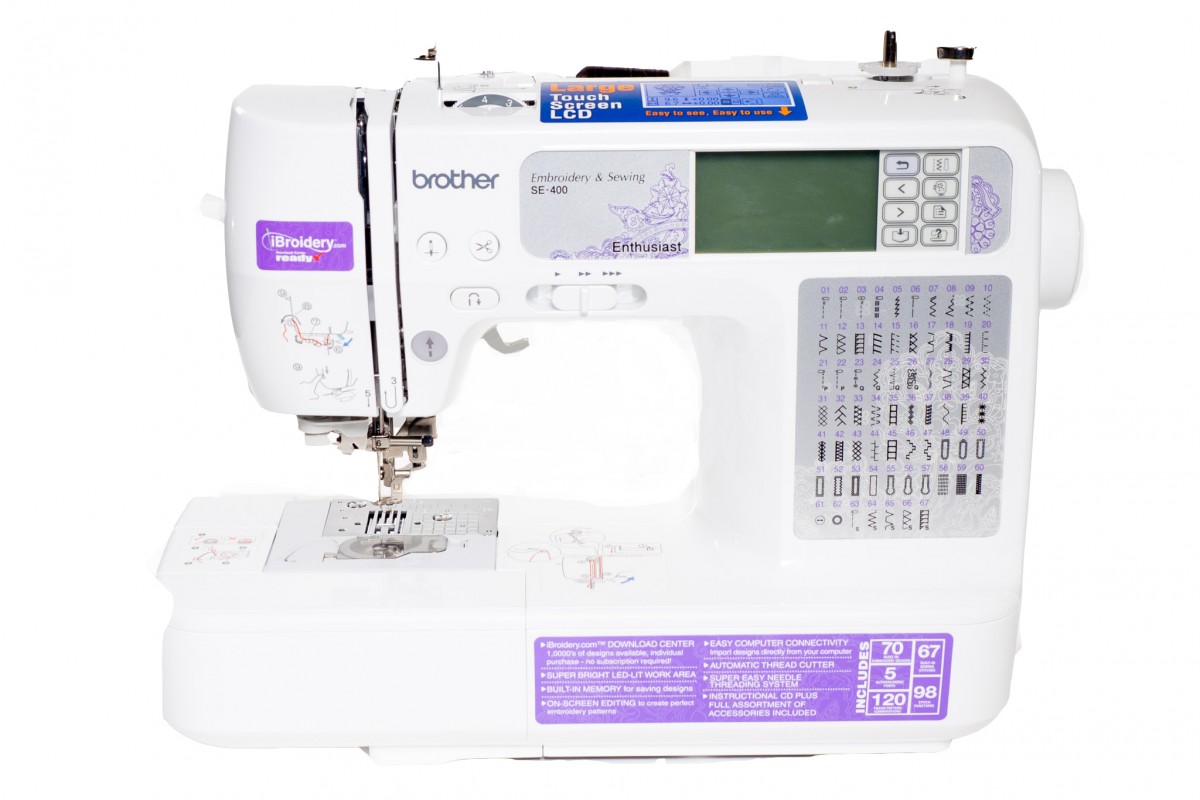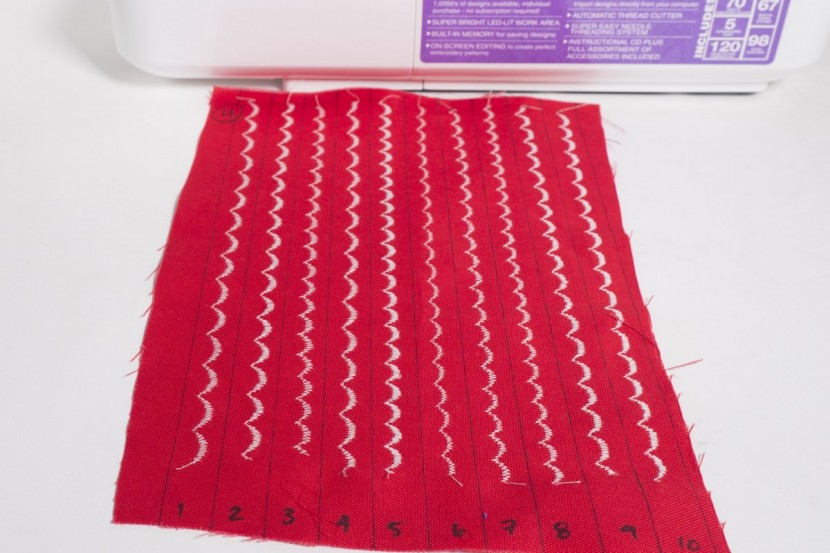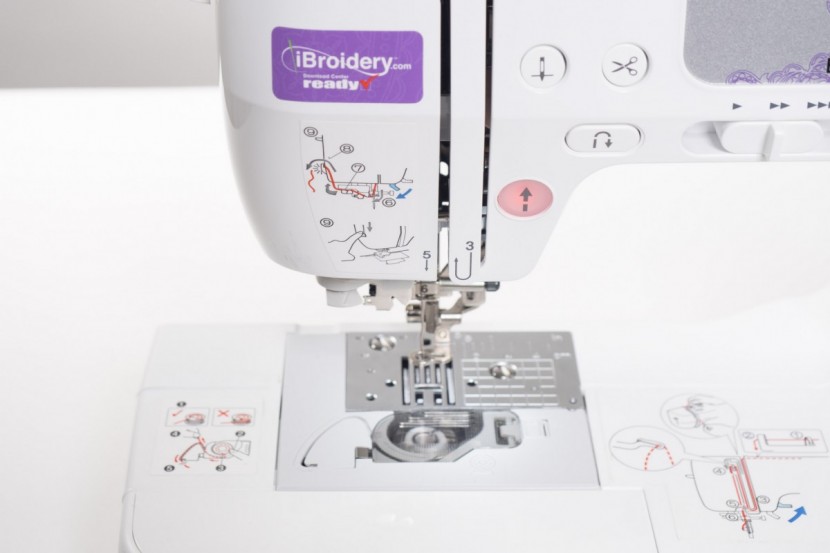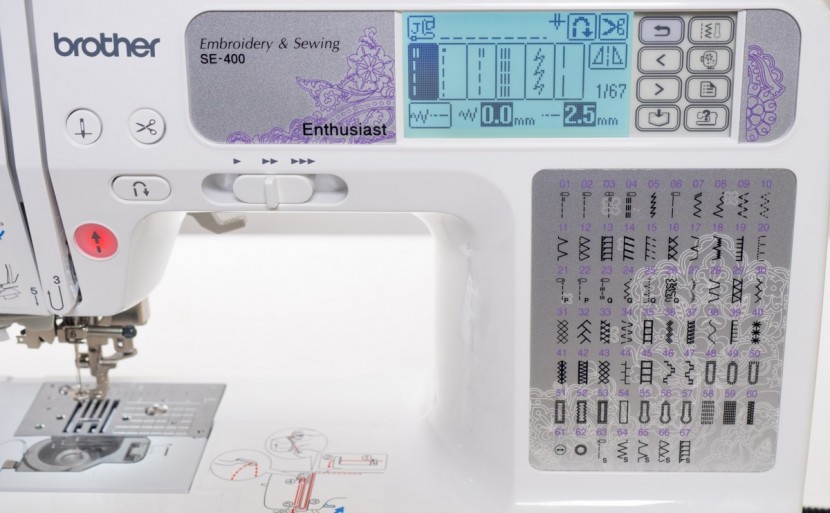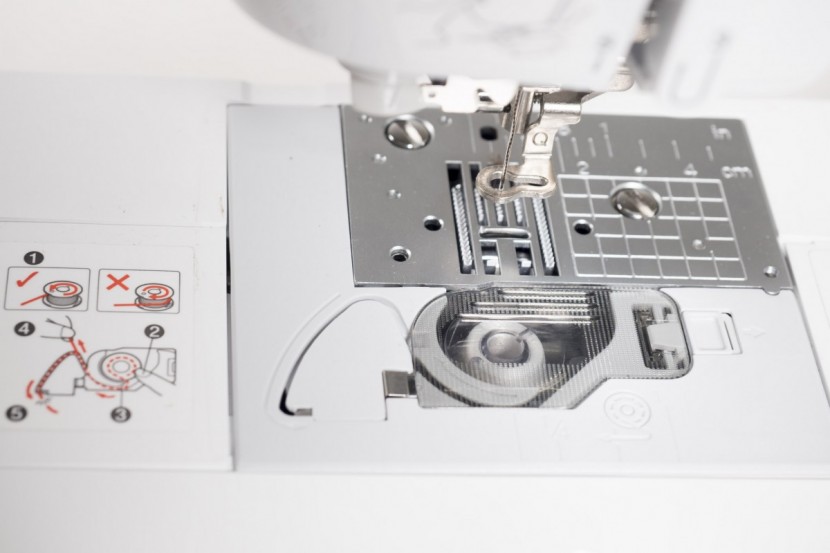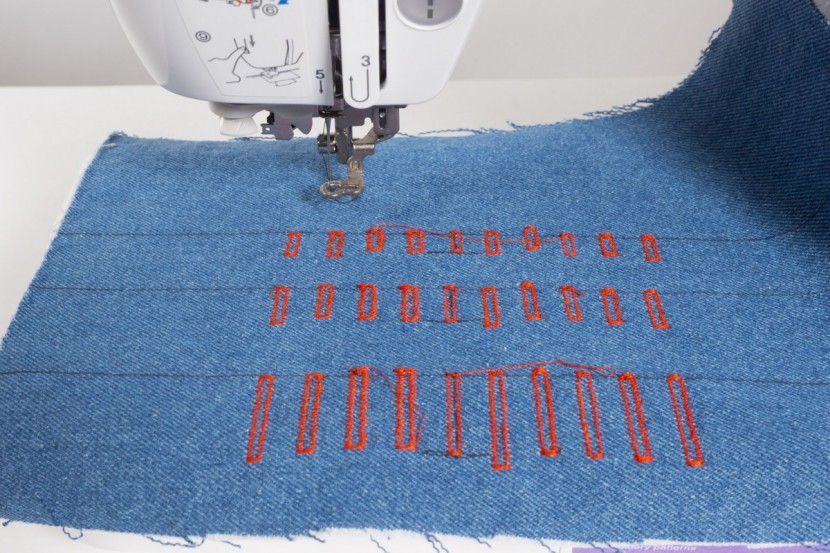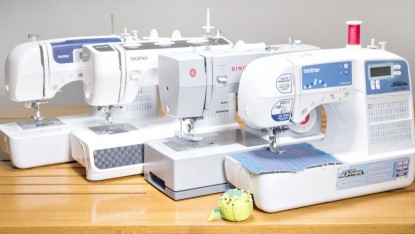Brother SE400 Review
Our Verdict
Our Analysis and Test Results
The SE400 combination machine functions as a typical sewing machine, with the option to add an embroidery foot to convert it into a computerized embroidery machine. We tested this machine as a sewing machine, where it trailed slightly behind our top scorers, earning a 67 out of 100. We didn't score the embroidery function, as we had no other machines to compare it too, but we did test it out with the stock designs and were impressed by the results.
On the right you see the SE400 with the embroidery foot ready to create some awesome patterns!Sewing
The SE400 did well in our sewing tests, earning a 6 out of 10. This rating metric was our most important out of our testing, making up 40% of the total score. We specifically compared the quality of zigzag, scallop, and long, straight stitches produced by each of the machines, as well as their performance attaching a zipper using the specialized presser foot. We were looking for even, consistent stitches that were not prone to unraveling across a wide variety of fabric types.
This machine did well across the board, particularly excelling at the scallop stitch and attaching a zipper. The scallop stitches were aesthetically pleasing, and the zipper stitches were even and consistent, with the presser foot clearing all parts of the zipper.
We did notice a few drawbacks on the zigzag and the long straight stitches. The bobbin thread on the zigzag stitch seemed to stay narrower than the top thread, causing the stitch to lose all of its stretchiness. This was particularly noticeable on the woven cotton, or jersey knit fabric. We felt that the stitches were a little on the loose side, and seemed slightly more prone to unraveling than some of the other machines. All in all, the SE400 did above average with sewing performance, and while we did spot a few flaws, there were no absolute deal breakers, and this machine does a competent job at sewing.
While we didn't evaluate the embroidery performance of this product (as none of the other models had this feature to compare it to), we did test it out, making a handful of the patterns pre-loaded on the machine, as well as a few other logos.
Ease of Use
This was one of the easier to use products that we tested, earning a 7 out of 10 on ease of use and a spot in the second tier of machines. To assess how easy each of these models were to use, we analyzed how clear and intuitive it was to use the machine, the level of illumination provided over your workspace, the type of thread cutter, and any other adjustments or features that made our lives easier when sewing.
The SE400, being a combination sewing/embroidery machine, has a large number of features and functions, making it almost impossible to have clear directions printed on the machine for every possible adjustment. We found that directions for the basic functions were clear, but that it was necessary to consult the manual when navigating through the various menus and submenus on the the touchscreen.
The light provided by this machine was adequate, but it would still be necessary to have supplemental light available. This machine is a little more confusing when selecting stitches than some of the simpler machines, navigating through the menu rather than matching up numbers or dials to a key printed on the machine. The available library of stitches was not the largest — understandably so, as this machine has a library of embroidery stitches, as well as the capability to add additional files through a USB flash drive.
This machine does have automatic sewing, with the convenient feature of a backlit start button. This light will only turn green when the machine is ready to start sewing, preventing you from starting and making a mistake like leaving the presser foot up. The needle will also always stop in the down position.
One final feature that we absolutely loved on this machine was the automatic thread cutter. As mentioned above, the needle will always stop in the down position, until the thread cutter is engaged. After hitting the button, the machine will raise the needle, and cut both the upper and lower thread.This is a fantastic feature, as it saves copious amounts of thread (and money!) in the long run, as well as minimizing the long thread tails that always seem to accumulate into a mess while sewing.
Ease of Setup
For being such a sophisticated and complicated machine, the SE400 actually netted the top score when it came to ease of setup, earning an 8 out of 10. For quick projects, setting up the machine can take as much time as actually sewing, and a machine that is confusing and complicated to setup can be a strong deterrent in undertaking a new project. This rating metric consisted of looking at the difficulty associated with threading the machine and the needle, and winding and installing the bobbin. First off, this machine had the easiest automatic needle threader by far, actually living up to its namesake phrase: automatic needle threader.
Compared to other machines that required a decent amount of dexterity to use the needle threader, the SE400 has you route the thread through all the numbered locations, then pull a lever. This spring-loaded mechanism cuts the thread and threads the needle at the same time, making this a great choice for someone with limited dexterity or anyone else who routinely struggles with threading the needle. This machine also scored the best at winding the bobbin and installing it, winding an even bobbin and displaying clear directions on how to install it and route the bottom thread. There was even a tiny blade tucked under the bobbin cover, trimming it to the perfect length every time.
Button work
The final aspect of these machines that we looked at was the ease of setting up and making a buttonhole, as well as the quality of the finished project. The SE400 did an acceptable job, scoring just above average with a 6 out of 10. This product completes a 1-step buttonhole that will stop automatically, making it less prone to human errors than some of the mechanical machines. It was pretty much average to line the foot up in the desired location, and we didn't notice any unraveling on the finished product.
The only flaw we found was the presser foot for buttonholes was identical to other Brother machines, making it prone to the same problem of the foot catching tiny fibers and dragging the fabric along, making certain fabrics prone to bunching.
Value
While this machine is one of the most expensive that we looked at, it can be a great value for someone that is looking to do both embroidery and sewing. Rather than spending between $800-$1000 for a dedicated, quality sewing machine and a quality embroidery machine, you get both for the price of one. However, if you aren't interested in machine embroidery, or don't think you will use it frequently, you would be better served by purchasing a higher ranked sewing machine at a lower price.
Conclusion
The SE400 performed admirably well for a combination machine, earning its place near the top on its sewing performance around. It did a solid job when it came to sewing quality, though not the best, and thoroughly excelled when it came to ease of setup and ease of use. This is a perfect product for those that are looking to dive a little deeper into textile project, and will benefit by the addition of embroidery to their sewing projects. This would also be a great purchase for someone who really struggles with the most dexterous tasks on their current machine — someone who may have reduced eyesight or dexterity — and are willing to pay a premium to ease that struggle. The high price and runner-up performance precluded this machine from winning the top award, but it still is a machine to think about if the above characteristics would apply to you.


